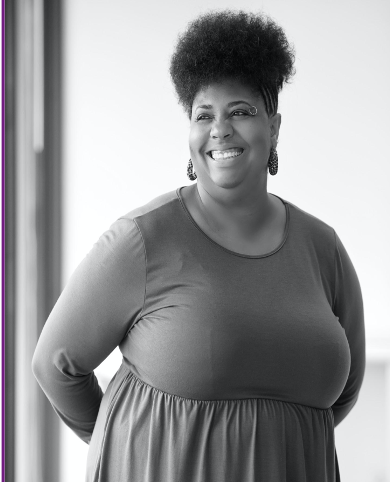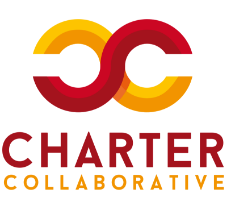
Shayne Swift
Co-founder & Principal, Girls Global Academy Public Charter School
Girls Global Academy Public Charter School
Location: Washington, DC
Year Opened: 2020
Student enrollment: 66
Grades served: 9th grade
Website: www.girlsglobalacademy.org
Student Demographics
Black/African-American: 89%
Hispanic/ Latino: 8%
Hawaiian/Pacific Islander: 1.5%
Two or more races: 1.5%
Homeless Students: 3%
FRPM/FRPL %: 50%
Students with Disabilities: 32%
ELL/ESL Students: 0%
A FROM AT-RISK YOUTH TO EDUCATOR
I’m a fourth generation native Washingtonian. I’m fortunate to live in the house I grew up in, because my great grandmother was the first person to live here. I’ve watched my neighborhood in upper northwest change
drastically. All the families were Black families when I was growing up here.
Now, we’re one of two Black families still on our side of the street. That’s one facet of how I see marginalization in the city.
Growing up, I had to manage a lot early on: My parents separated when I was 4, my mom suffered from multiple sclerosis (MS) and wasn’t able to work, and my sister and I became latch-key kids. We had to do the grocery shopping, and I learned to cook .In school, I felt bored a lot, because I wasn’t learning things that were important to me. As I got older my teachers would say, “Shayne is really bright, but she talks too much. If she could just focus, she could do better.” I had undiagnosed ADHD and was what one would consider an at-risk student. My teachers didn’t know what was going on in my house; they didn’t realize how depressed she was and what a toll her disability was taking on our family.
My mother was a fierce advocate for herself, and she taught me how to advocate for myself. When I wasn’t selected for the Gifted and Talented program in 5th grade, I went to see my teacher, Miss Phillips, to ask why I wasn’t chosen. I told her I was just as smart as the other kids and I was offended. She put me into the program, because I pushed back.
I always knew I wanted to be a teacher. My first job, through Mayor Barry’s Summer Youth Employment Program, was tutoring kids in summer school. I was only 14 and trying to wrangle a bunch of 3rd graders, but I loved it. My family also had a big influence on my goal of being a teacher. My mom studied elementary education when she went back to school, but she wasn’t able to execute her vision due to her disability. She lived her dream vicariously through me.
After high school, I stayed local and went to Howard for college, because I wanted to be close to my mom. When I graduated, I started teaching at Shaw Junior High School, but I was riffed. I was really mad and didn’t
step back in the classroom for 6 years. Eventually, I got a teaching job at Parkdale High School, which is where I met Karen. We became fast friends and started talking in 2010 about starting a school. We hashed out a lot of ideas, but they stayed on Google Drive for about 5 years. Then, I learned about the Project XQ Competition on Twitter. We made it to the semifinals, but we didn’t have a charter on file, so we couldn’t implement our vision within the timeline. That gave us spark, though, to say maybe we have something here and move forward with it.
We kept getting close to submitting our charter application, but we couldn’t get it into good enough shape just by working on it on evenings and weekends. We found City Bridge, which gave us the opportunity to take a leap of faith. We knew it meant giving up health insurance, other benefits, and our pension, but we decided to leave. It’s the best thing we could have ever done.
HELPING GIRLS BECOME THEIR FULL SELVES
Because of what I experienced as a student growing up, I wanted to start a school to serve girls like me. Our goal in designing the school was to create a place where they feel safe, where they can confide in people, and where they feel support and love and have people with high expectations for them.
We want to help students find their voices, channel their voices, try on different leadership identities. Our goal is to support our students even when they’re trailing off a success path and use asset-based language to get them to understand that they can get back on track. Girls of color, in particular, are so used to stereotype threat, so there’s some unlearning we have to do with our students. Karen and I have spent the last few years unlearning that as well. You don’t have to be perfect. A lot of girls receive the message that they have to be good and perfect and feminine. We teach our girls that they can have different identities and it’s okay.
We celebrate our girls with Pillar Awards that recognize Sisterhood, Scholarship, Service and Safety. We practice micro-affirmations in classrooms and bigger affirmations in community meetings that happen every Wednesday. We could be celebrating something as simple as a student turning in all of her assignments on time. The other students really get into it and contribute to telling her what a great job she did. We need to continue to do that even when students are challenging us. They need that constantly as they move forward.
THE IMPACTS OF COVID
COVID has given me a lot more to think about. Our students all take business and engineering in 9th grade so they have opportunities to take risks. Through this experience, I’ve realized that those design and entrepreneurial mindsets are going to help our girls adapt and flex.
This experience has taught me how important relationship building is. It’s harder to do virtually, especially if you’ve never met somebody in person. The relationships that we’ve developed with families and with students, showing up to houses to deliver welcome baskets, dropping off hotspots and supplies, driving a Math book to a new student, families don’t expect to be treated that way. They’re grateful that somebody would take the time to do that. That’s been the saving grace of this all. Those relationships have become really important for us.
I’m glad we opened despite it all, because we’re needed. We didn’t get the number of girls we wanted, but that’s okay, because we really appreciate the chance our current families took on us.
CHARTER LEADERS OF COLOR MATTER
Bringing authenticity and our experience as mothers of girls the same age as the girls we’re serving has been really important for our families. I’m proud to be a charter leader of color, because I feel like I’m leading by example. We just showed our girls that 10 years of a dream can happen if you stick with it. If the goal truly is the goal, taking it seriously, surrounding yourself with like-minded people. It’s great for our girls to see people who look like them every day in the seat.
When I think about the future of education, I want our students to see more of themselves in the classroom, more of what’s important to them. We need to ensure that kids know why they’re doing what they’re doing and they’re carving out their own personal and meaningful why.
